Brown or White: Which Rice Is a Healthier Choice for Your Diet?
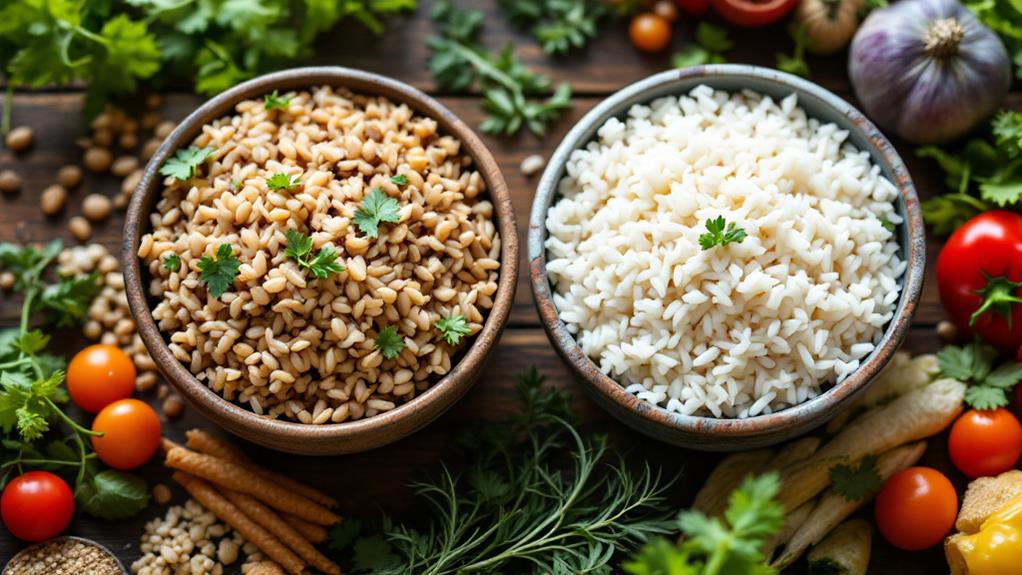
If you're deciding between brown or white rice for your diet, consider your nutritional needs. Brown rice retains bran and germ, offering more fiber, B vitamins, magnesium, and a lower glycemic index. It supports digestion, blood sugar control, and weight management. White rice has fewer nutrients but cooks faster and is often enriched with iron and folic acid. It's milder in flavor and versatility suits different cuisines. Be aware of brown rice's potential arsenic content and its higher fiber possibly causing digestive discomfort. Contemplate your health goals and preferences to make an informed choice, enhancing your dietary knowledge further.
Varieties of Rice
When exploring the world of rice, you'll uncover a diverse array of over 8,000 varieties cultivated globally, each offering unique colors, textures, and flavors. Among the most commonly encountered are white rice and brown rice. White rice is the more processed of the two, having had its bran and germ removed, which results in a smoother texture and a quicker cooking time. Brown rice, on the other hand, retains its bran and germ, providing a chewier texture and a nuttier flavor.
Rice varieties can be further categorized by grain length: long-grain, medium-grain, and short-grain. Each type serves different culinary purposes. Long-grain rice, like basmati, remains separate and fluffy after cooking, perfect for dishes like pilaf. Medium-grain rice, such as Arborio, is ideal for creamy risotto, while short-grain rice is sticky and often used in sushi.
Specialty rice varieties, including jasmine and basmati, are celebrated for their distinctive aromas and textures. Furthermore, colored rice varieties like red, purple, and black rice not only improve dishes with their visual appeal but also contribute rich antioxidants. Each variety brings something unique to your meals, making rice a versatile staple.
Nutritional Differences
Understanding the nutritional differences between brown and white rice can help you make healthier choices. Brown rice stands out as a whole grain, retaining its bran and germ, which enhances its nutritional value. This means it provides more fiber—3 grams per cup compared to white rice's 0.5 grams—along with vital nutrients. You'll find that brown rice is nutrient-dense, containing about 248 calories and 52 grams of carbohydrates per cup, while white rice has 205 calories and 45 grams of carbohydrates.
Brown rice is packed with B vitamins, magnesium, phosphorus, and selenium. In contrast, white rice often undergoes enrichment, adding back iron and folic acid lost during processing. The glycemic index (GI) also highlights a significant difference: brown rice has a GI of about 50, meaning it causes slower blood sugar spikes, while white rice has a higher GI of 89, leading to quicker increases in blood sugar levels.
Health Benefits
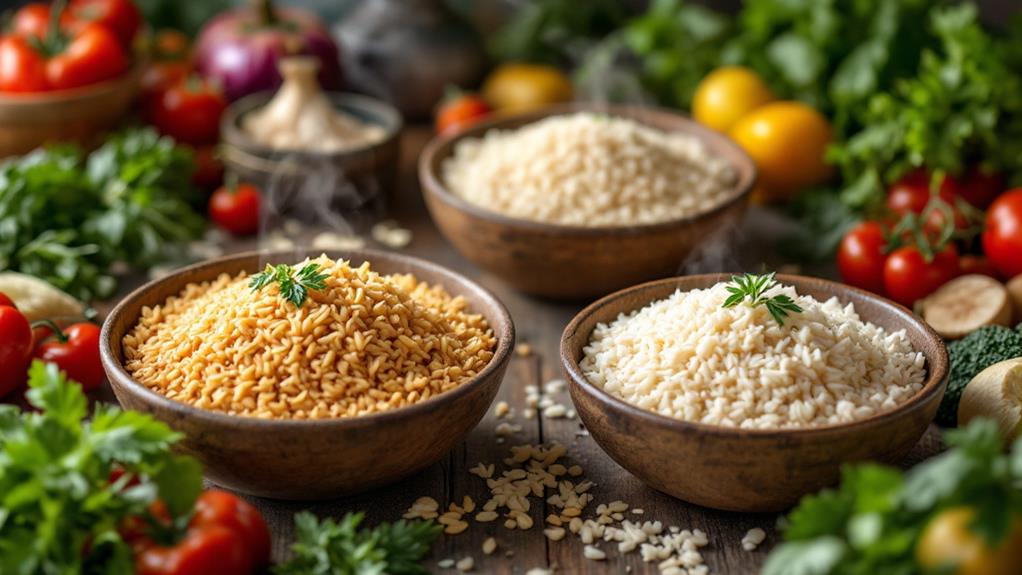
Embracing the health benefits of brown rice can greatly improve your well-being. Brown rice stands out as a whole grain rich in fiber, which aids digestion and helps manage cholesterol levels. In contrast, white rice undergoes processing that strips away most of its fiber, leaving it with minimal content. This makes brown rice a superior choice for promoting digestive health and keeping your heart in check.
When it comes to blood sugar control, brown rice takes the lead with its lower glycemic index of around 50. This means it causes a slower, steadier increase in blood sugar levels compared to white rice, which has a glycemic index of 89. If you're managing diabetes, brown rice may be the healthier choice.
Brown rice is also packed with vital nutrients like magnesium, phosphorus, and B vitamins, while white rice often gets enriched with fewer nutrients after processing. Furthermore, the antioxidants and complex carbohydrates in brown rice contribute to reducing the risk of type 2 diabetes and bolstering heart health. In addition, its high fiber content promotes satiety, aiding in weight management, unlike white rice, which can lead to quicker blood sugar spikes and potential weight gain.
Cooking Techniques
Getting the hang of cooking brown rice can seem tricky at the outset, but with the right techniques, you'll find it rewarding. Brown rice requires patience, as its cooking time is around 45-50 minutes, compared to the swift 15-20 minutes for white rice. However, this longer cooking time is worth it for the nutritional benefits. Start by rinsing brown rice thoroughly. This step reduces arsenic levels and removes excess starch, resulting in a better texture and flavor.
The water to rice ratio is essential for perfect results. For brown rice, use a 2:1 ratio, meaning two cups of water for every cup of rice. White rice, on the other hand, typically uses a 1.5:1 ratio. If you want to speed things up a bit, soak the brown rice for a few hours beforehand, which can help reduce the cooking time and improve texture.
Here's a quick guide to make the process easier:
- Rinse thoroughly to improve texture and flavor.
- Use the correct water to rice ratio for best results.
- Soak for faster cooking and better texture.
- Consider using a rice cooker for consistent results.
These techniques guarantee deliciously cooked brown rice every time.
Flavor Profile
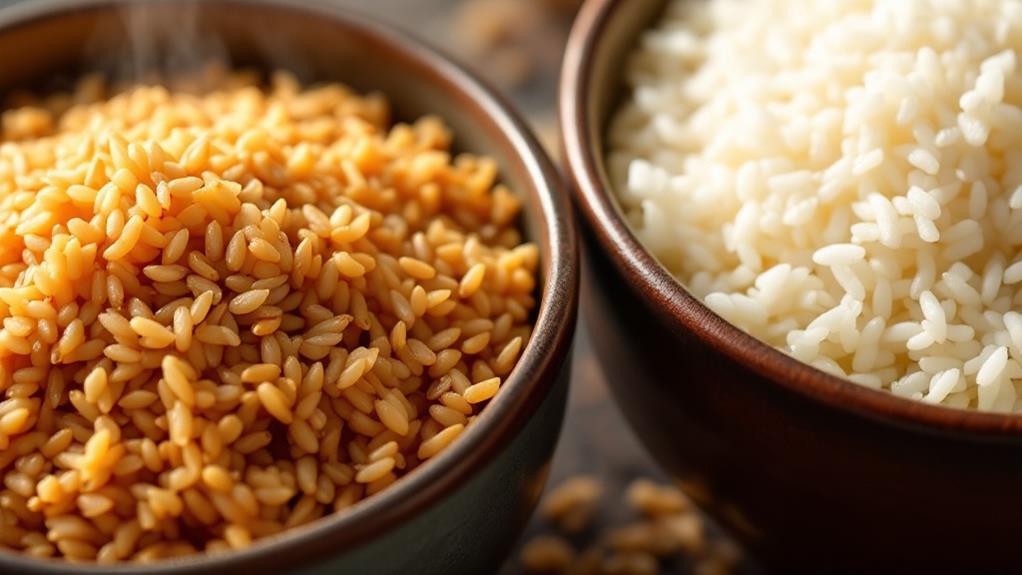
Having mastered the art of cooking brown rice, you can now appreciate its unique flavor profile. Brown rice delivers a nuttier, earthier taste, thanks to its intact bran and germ. This robust flavor shines in hearty meals and pairs beautifully with savory dishes. By adding herbs, spices, or broth during cooking, you can improve its slightly chewy texture and depth, making it a standout choice in salads and grain bowls. If you enjoy a pronounced flavor, brown rice won't disappoint.
On the other hand, white rice offers a milder, more neutral flavor profile. It's softer and fluffier, which makes it incredibly adaptable across different cuisines. Its subtle taste acts as an excellent base for stir-fries, curries, and dishes where it serves as a filler. White rice's absorptive nature allows it to soak up sauces and spices effortlessly, making it a preferred choice when you need a quick cook time and a light taste.
Ultimately, your preference for brown or white rice depends on the flavor profiles you seek in your meals. Regardless of whether you crave the boldness of brown rice or the adaptability of white rice, both have their distinct culinary roles.
Environmental Impact
When considering the environmental impact of rice production, brown rice typically has a smaller footprint due to its minimal processing requirements. Unlike white rice, which needs extensive milling and refining, brown rice retains its bran layer, requiring less energy. This reduced processing translates into a lower environmental cost, favoring brown rice as a more sustainable option.
White rice cultivation often demands more water and fertilizers, leading to increased environmental strain. It poses risks like soil degradation and water pollution, especially when monoculture practices are employed. In contrast, brown rice farming may support soil health through crop rotation, promoting biodiversity and healthier ecosystems.
Here are some key points to understand the environmental differences:
- Processing Requirements: Brown rice involves less processing, reducing energy consumption.
- Water and Fertilizer Use: White rice tends to need more, impacting ecosystems negatively.
- Farming Practices: Brown rice is often linked to crop rotation, enhancing soil and biodiversity.
- Consumer Influence: Preferences for brown rice can drive sustainable agricultural practices.
Ultimately, the environmental impact of rice production varies by region, but opting for brown rice can support more eco-friendly farming, aligning with an increased awareness of environmental issues.
Dietary Considerations
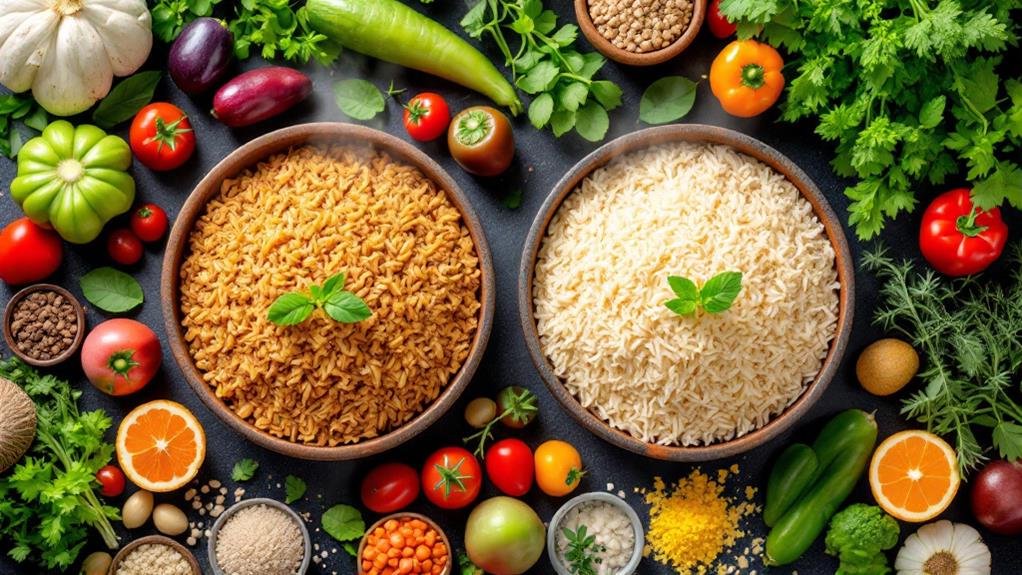
Brown rice stands out as a nutrient-dense option, rich in fiber and essential nutrients, which makes it a healthier choice compared to white rice. As a whole grain, brown rice retains its bran and germ, offering about 3 grams of fiber per cup, while white rice, stripped of these components, provides less than 1 gram. This difference in fiber content can greatly impact your diet, aiding digestion and helping you feel fuller longer, promoting a healthy weight.
The glycemic index of brown rice is approximately 50, making it a smarter choice for blood sugar control compared to white rice's index of around 89. This means brown rice can help manage your blood sugar levels better, which is critical if you're focusing on a healthy diet aimed at preventing type 2 diabetes. Regularly including brown rice in your meals can also contribute to improved heart health.
However, if you have digestive issues or need a low-fiber diet, white rice may be easier to digest due to its softer texture. To achieve a balanced diet, consider mixing both brown and white rice or exploring other whole grains, enhancing both variety and nutritional intake.
Potential Risks
While brown rice boasts several health benefits, it is crucial to be aware of potential risks associated with its consumption. One significant concern is the presence of arsenic. Brown rice contains higher arsenic levels than white rice, posing health risks, especially over long-term consumption. Vulnerable groups, like pregnant individuals, should be particularly cautious. Another issue is digestive discomfort. The high fiber content in brown rice can be problematic for those with conditions such as diverticulitis or IBS.
Consider these potential risks when choosing rice:
- Arsenic: Brown rice has more arsenic, which can be harmful if consumed in large quantities.
- Glycemic Index: White rice has a high glycemic index, leading to rapid blood sugar spikes, increasing the risk of metabolic syndrome and type 2 diabetes.
- Nutrient Gaps: Relying too much on either rice type without a varied diet might cause vital nutrient deficiencies.
- Phytic Acid: Present in brown rice, it may hinder absorption of minerals like iron and zinc, potentially leading to deficiencies.
Balancing your rice intake with diverse food sources can help mitigate these risks, ensuring a healthier diet.
Making Your Choice
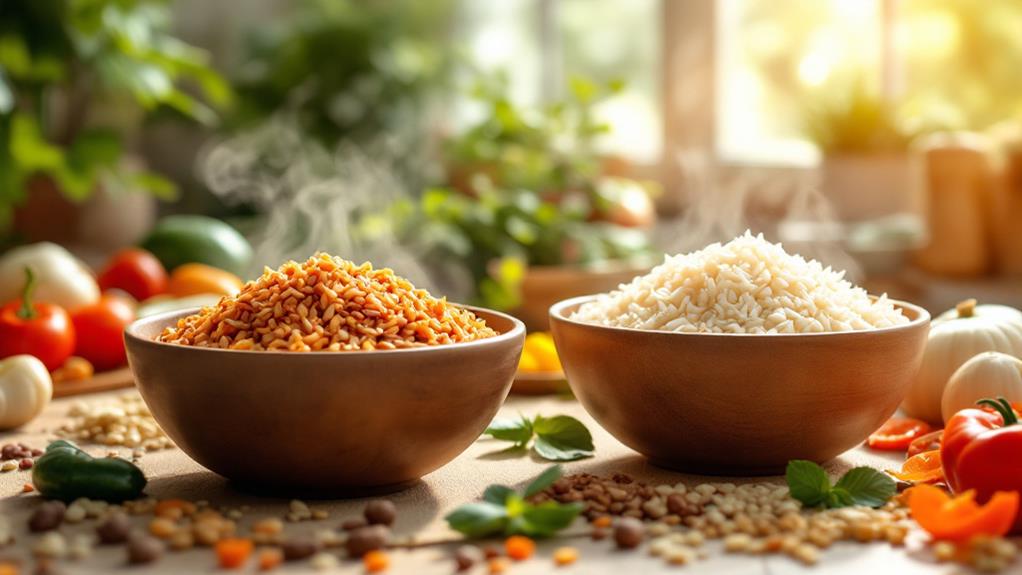
Considering the choice between brown and white rice involves weighing their unique benefits and drawbacks to suit your lifestyle and health needs. If you prioritize a healthy diet rich in fiber and nutrients, brown rice is a solid option. As a whole grain, it retains its bran and germ, offering more fiber, magnesium, and B vitamins. These nutrients can support digestion and heart health, making it a great supplement if you're aiming for a nutritious meal plan.
On the other hand, white rice is a refined grain stripped of its bran and germ, which results in a lower fiber content and a higher glycemic index. This characteristic might lead to quicker spikes in blood sugar, but it also means white rice cooks faster and is gentler on the stomach. If you have digestive issues or require a milder grain, white rice might be more suitable for you. Furthermore, it's often enriched with iron and folic acid, adding some nutritional value.
Ultimately, the decision between brown and white rice should align with your health goals and personal preferences. Both can fit into a balanced diet, offering their own advantages depending on your needs.




